HOUSTON — The circle of students sat quietly, scribbling down answers to the prompt they’d just been given: “Write down three similarities between the Holocaust and abortion.”
After a minute or two, they launched into discussion. Innocent people were, and are, being killed, they said. The Nazis discriminated against the Jews, just as “the unborn” face discrimination today. Bystanders aren’t doing enough to stand up against injustice.
Sarah Ruiz, the Texas A&M University senior leading the group, added another idea. Sometimes, she said, people who support abortion rights will say they wouldn’t get an abortion but they don’t want to stop anyone else from getting one.
“You can draw parallels ... to slavery, to child abuse, to animal cruelty,” she told her students, as other clusters of students debated the same topic nearby. “‘Well, I wouldn't kill my neighbor. But what you do is up to you. I wouldn't beat my child. But what you do is up to you. I don't like slavery, don’t own a slave.’
“You can plug in literally anything into that.”
As Ruiz spoke, her voice soft and solemn, her pupils nodded along, their faces determined. This was, after all, very serious business: If they could convince someone that abortion in the United States is a holocaust, they might be able to keep them from getting one — and save a life.
Welcome to pro-life boot camp.
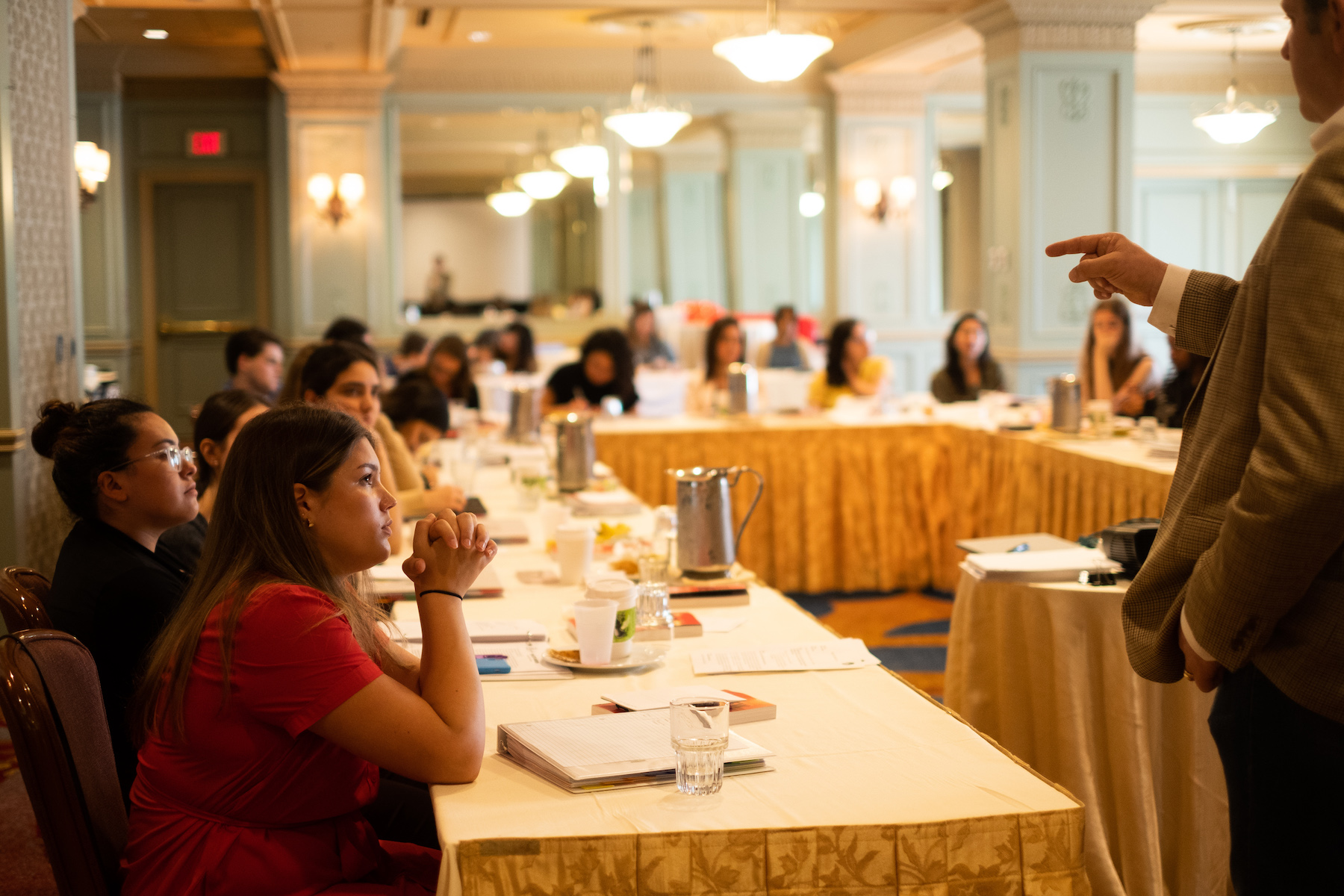
In June, 24 Texas college students spent a week of their summer break at a hotel in downtown Houston, learning how to become anti-abortion activists through the Dr. Joseph Graham Fellowship for College Pro-Life Leaders. The seven-day training is run by Texas Right to Life, the Lone Star State’s preeminent anti-abortion group. Afterward, in exchange for 50 hours of activism, participants will receive a $1,000 scholarship every semester.
This school year alone, Texas Right to Life is investing almost $100,000 in new students, between these fellows and 25 others who participated in a training in July. (It’s their largest class since the fellowship began, in 2008.) That’s not counting the cost of the four-star hotel, students’ travel, older fellows’ scholarships, or the programs that the group runs for high school students and graduate students.
But for Texas Right to Life, it’s worth it. Because as countless speakers will remind them over the course of the week, the fellows make up the front lines of the national war over abortion rights. And with President Donald Trump in the White House, a majority-conservative Supreme Court, and a spate of abortion bans sweeping across the South, it’s a war they’ve never been closer to winning.
“Well, we are trying to save the world,” said Veronica Arnold Smither, the head of Texas Right to Life’s education division, with a wry smile and a snap of her fingers, as if to punctuate the obvious.
The group is just one of many that are training students; anti-abortion summits, conferences, and camps similar to this one, run by both national and state-level groups, dot the country.
“Life begins at the beginning. There's no arbitrary line here. So it's black and white. It's yes or no. It's life or death.”
These ground soldiers in Houston don’t look much like the stereotypical anti-abortion activists angrily picketing clinics on a Sunday. They’re polite, curious, and generally like all other college students, chatting together about struggling to wake up early and who Hannah should end up with on “The Bachelorette.” In interviews, some declined to label themselves as “Republicans”; some said they support traditionally Democratic causes, like gun control and ending the death penalty.
Sure, many were Christian. Breakfast always included a group prayer, and talk of Jesus saturated speakers’ lectures. One young woman floated away from her conversations with a VICE News reporter with a sincere trill of “Blessings!” But the fellows regularly insisted that their anti-abortion beliefs were not rooted in their religion, and over the course of the week, they were not taught to argue that God believes abortion is a sin.
Rather, they practiced using secular, biology-based arguments to convince skeptics that life begins at conception. They listened to lectures that traded on the terminology and tenets of social justice causes. In short, they learned how to harness their enemies’ weapons of choice, including feminism.
“We’re not 40-something-year-old women with 11 children and a long braid. We’re not a rich white man making policy,” said Therese Delgado, an incoming freshman at the University of North Texas with impressive posture and a fondness for cool, witchy black heels. “We’re a diverse body of kids — and just past kids — who have these beliefs, who are living in the modern era, and affected by all the issues that affect young people today. But we happen to have these beliefs on top of that.”
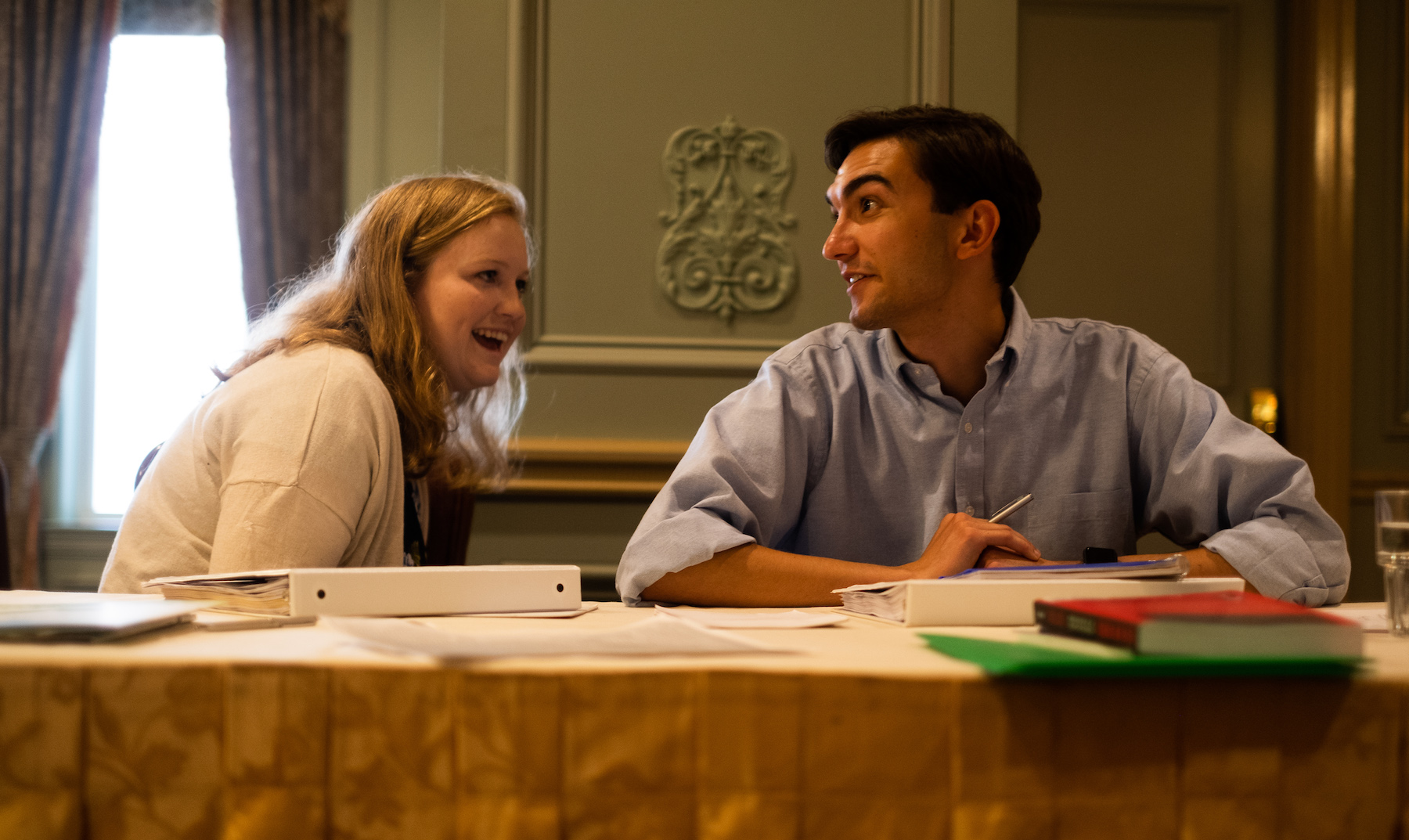
By the standards of the anti-abortion movement, these fellows’ beliefs were often uncompromising. Some do not support abortions even in the case of rape or incest, and Texas Right to Life taught them that common hormonal birth control methods, like the pill, the patch, and IUDs, could induce abortions.
Such attitudes set these students apart from many of their liberal-leaning Generation Z peers. In a survey this year, 62% of Americans between the ages of 18 and 29 told Gallup they consider themselves “pro-choice”; just 33% said they’re “pro-life.” Thirty-six percent of young Americans said they thought abortion should be “legal under any circumstances” — more than any other polled age group.
On the first afternoon of the June training, a Sunday, a group of fellows wearing royal-blue polos with a red Texas Right to Life logo settled onto lobby couches. They’d all met just minutes before but quickly found themselves nodding in agreement with one another.
“It’s comforting, having people that believe the same things as you,” said Liz Miller, a rising senior at Stephen F. Austin State University. “There’s a lot of people our age that are pro-choice, and so it’s nice to have the pro-life movement be like, ‘You’re not alone.’ I stand in my truth, and I stand in this, and it’s empowering.”
Another student chimed in, “It’s nice to be around people who aren’t always arguing with you.” One laughed, and others murmured “yes,” “ yes.”
“By forming this sort of web of people at various universities, you’re attacking what is essentially a lot of the pro-choice source at the heart of it, in university campuses,” Gunnar Osteen, who will be a sophomore this fall at the University of Texas at Austin and who’s one of just four male students at the training, said later. “By forming that coalition, you’re able to effect change at a greater pace and a greater scale.”
“PRO-LIFE 101”
Throughout the week, students attended talks on subjects ranging from in vitro fertilization to the emotional consequences of abortion, as well as took field trips where they learned how to turn the lessons into action. One day, they went to a strip mall in western Houston to tour a pregnancy center, sandwiched between a liquor store and a gun shop, that hopes to convince women not to get abortions. On another trip, they gathered in a time-honored anti-abortion tradition: They prayed on the sidewalk outside a Planned Parenthood abortion clinic, for the women inside.
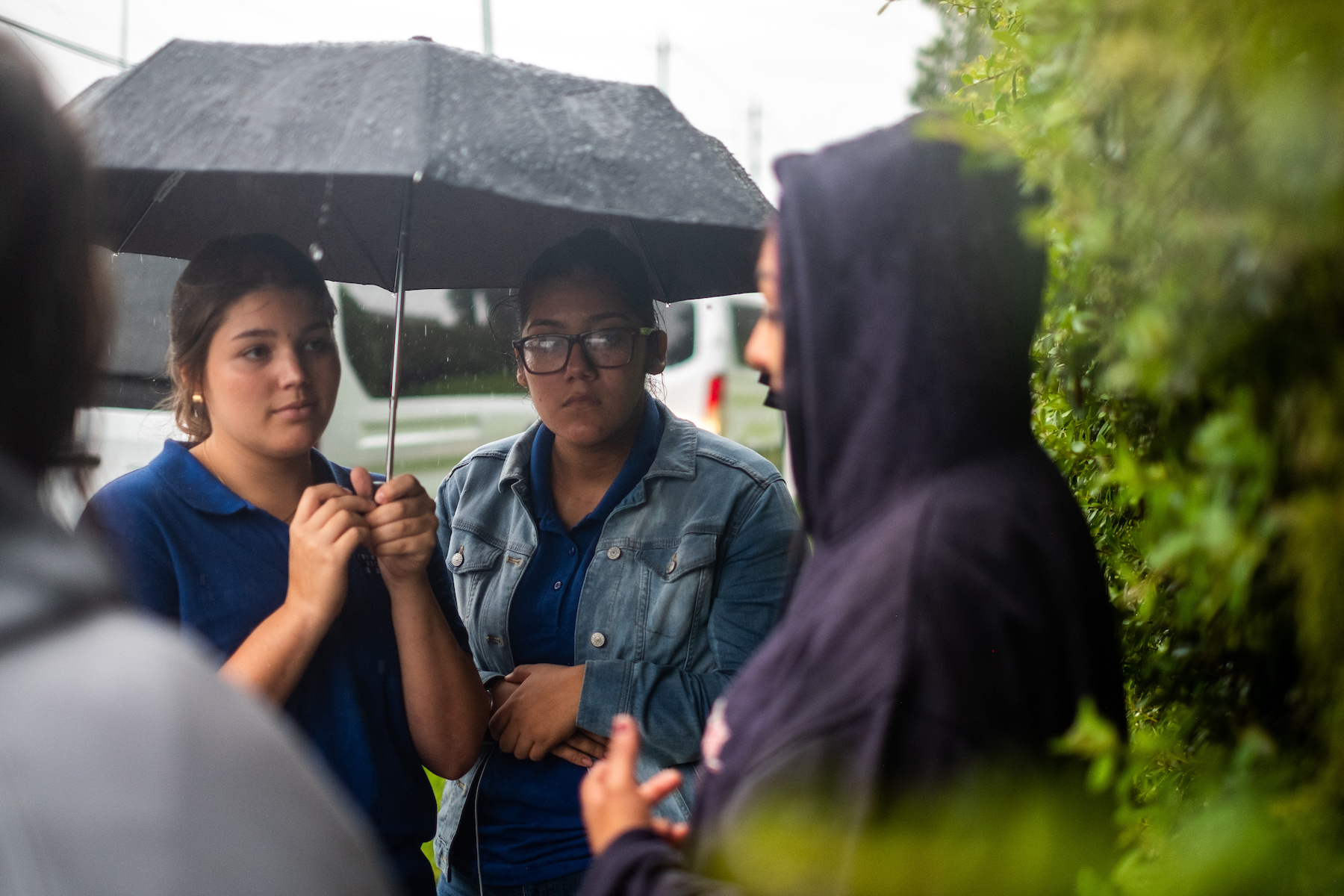
They also dived into the fundamentals of effective organizing. The students studied tactics to magnify a club’s presence on campus, like consistent branding on social media and writing a comprehensive mission statement.
All these activities were in the service of one mission, laid out on the first day of training, in a talk called “Pro-Life 101”: “I don't want abortion to just be illegal; I want it to be unthinkable,” Austin Cruz, a theology teacher at a local Catholic school, told the group.
That motto was reiterated endlessly throughout the week. During an exercise on body language when talking to strangers, Arnold Smither lobbed a question at the group: “What would you say is our ultimate, absolute goal as pro-lifers?”
Miller immediately rose onto her toes to answer, thrusting her arm — complete with a bright-blue rubber bracelet that read “PRO-LIFE” — into the air.
“To make abortion unthinkable,” she said promptly. It was, of course, the correct answer.
“They’re longing for the bigger picture,” Arnold Smither said of her program’s fellows, in an interview. “They're longing for the long-term strategy. And this training provides that. It provides them with science, history, political strategy, dialogue techniques, so that they can see the big goal at the end and learn, ‘OK, this is what we're actually going for.’”
Abortion foes’ plan has never been a secret: They want to overturn Roe v. Wade, the 1973 Supreme Court decision that legalized abortion nationwide. For years, they took a slow-but-steady approach, passing laws that gradually gnawed away at Roe’s protections. Between 2010, when Republicans seized majorities in many state legislatures, and 2018, they managed to enact 424 restrictions on abortion around the country — more than a third of all the anti-abortion laws passed since 1973.

But after Brett Kavanaugh’s confirmation to the Supreme Court late last year, Republican state legislators went for Roe’s jugular. In 2019, Mississippi, Louisiana, Georgia, Kentucky, and Ohio all passed laws that could ban abortion at as early as six weeks, before many people even know they’re pregnant. Missouri outlawed abortion as early as eight weeks.
A new law in Alabama bans all abortions except in cases where a pregnancy poses a “serious health risk” to the mother. There are no exceptions for rape or incest, and a doctor who performs the procedure could be imprisoned for up to 99 years.
None of these bans are in effect, thanks in part to court challenges. But if the surge of legislation alerted many to these activists’ long-gestating crusade, it also fueled anti-abortion young adults’ faith that Roe could be overturned within their lifetimes.
As long as they just work hard enough.
SEEING A MODERN-DAY HOLOCAUST
The urgency of the mission was made clear on the first full day of activities. Texas Right to Life kicked things off with two documentaries about the Holocaust, including one produced by the United States Holocaust Memorial Museum. While the training’s administrators stressed that abortion in the United States is not the same as the Holocaust wrought by Nazi Germany, they do see useful parallels.
After the videos, Arnold Smither walked students through a short history of post–World War I eugenics.
“One of the big proponents of eugenics in the United States, pre–World War II, was Margaret Sanger, the founder of Planned Parenthood,” she told them. “So it’s easy to see the slippery slope.”
This is true: Sanger courted eugenicists to her birth control movement by selling her mission as helping to rid the country of “the weeds” of humanity and “[breeding] a race of human thoroughbreds.” What’s less true is how that idea was echoed in a discussion minutes later, when one student said Sanger had gotten “a lot of her ideas from Hitler.”
The Holocaust Memorial Museum says it “unequivocally rejects efforts to create analogies between the Holocaust and other events, whether historical or contemporary,” but this remains a common comparison within anti-abortion circles. The text of the Alabama near-total ban declares, “More than 50 million babies have been aborted in the United States since the Roe decision in 1973, more than three times the number who were killed in German death camps, Chinese purges, Stalin's gulags, Cambodian killing fields, and the Rwandan genocide combined.”
By the time students show up at the Texas Right to Life training, they already know what they believe, but they want to be able to wield those beliefs to change hearts and minds. That’s never easy to do, but it’s especially perilous when you’re young, want friends, and are likely surrounded by classmates who disagree with you. So, much of the training focuses on learning how to engineer what one speaker called “courageous conversations and compassionate conversations.”
Spread out across the mirrored ballroom and second-floor hallway where many of the talks took place, students repeatedly role-played “tabling,” as though they had set up a table on campus to talk to students about abortion rights. They were encouraged to ask one another questions, to dig into any potential gaps between somebody's support for abortion rights and why they support them — and then, hopefully, widen those gaps, until there’s enough room for doubt.
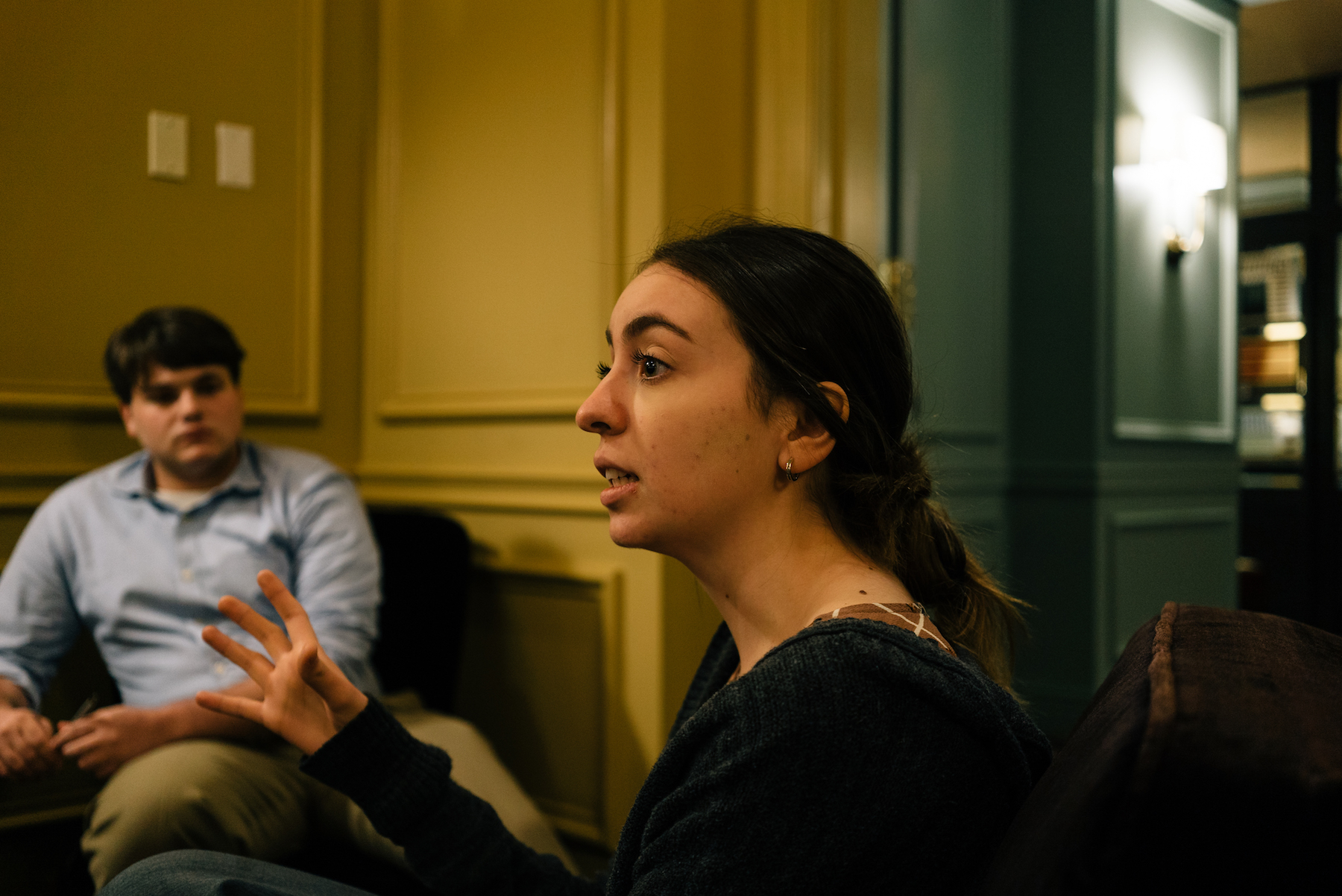
During one practice, Texas Right to Life education associate Rachel Bush stepped in with an encouraging smile after one fellow missed an opportunity to ask another why she doesn’t believe life starts at conception.
“Ask a follow-up question,” Bush advised. “Well, ‘why do you think — why do you pick that point?’ Because that’s gonna tell you a lot too.”
“So you can keep bringing it back to the questions, to get her to think, because sometimes people honestly just have not thought out their opinion,” she went on, adding, “And you’re building the relationship, too. So they feel like they can trust you, and you’re not just trying to force them to believe what you believe.”
Through this practice, students develop a small arsenal of responses to common pro-abortion rights arguments, though Arnold Smither said in an interview that they always encourage students to do more critical thinking and research on their own.
“After every talk, we give the students an opportunity to regurgitate what they learned with their partners,” she said. “They're looking at their notes and saying, ‘OK, if someone were to ask me, what do I do about these hard cases?’” (Such as rape, incest, or a pregnancy that threatens the life of the woman.) “So the students know how to respond to that, and respond with compassion and science and facts.”
“FACTS ARE IMPORTANT”
Thirty years old, 5’2”, and four months pregnant during the training, Arnold Smither is unfailingly unflappable, even when chasing after her young son, who loved toddling around the hotel. But hit on the right topic, like biology, and Arnold Smither’s passion for her cause cracks through.
“There are seven criteria for a living organism and a human zygote — one-celled zygote — has all seven of them,” she exclaimed, curling her index finger and thumb to demonstrate just how small that zygote might be. “A human being has all seven of them from the beginning, so life begins at the beginning. There's no arbitrary line here. So it's black and white. It's yes or no. It's life or death.”
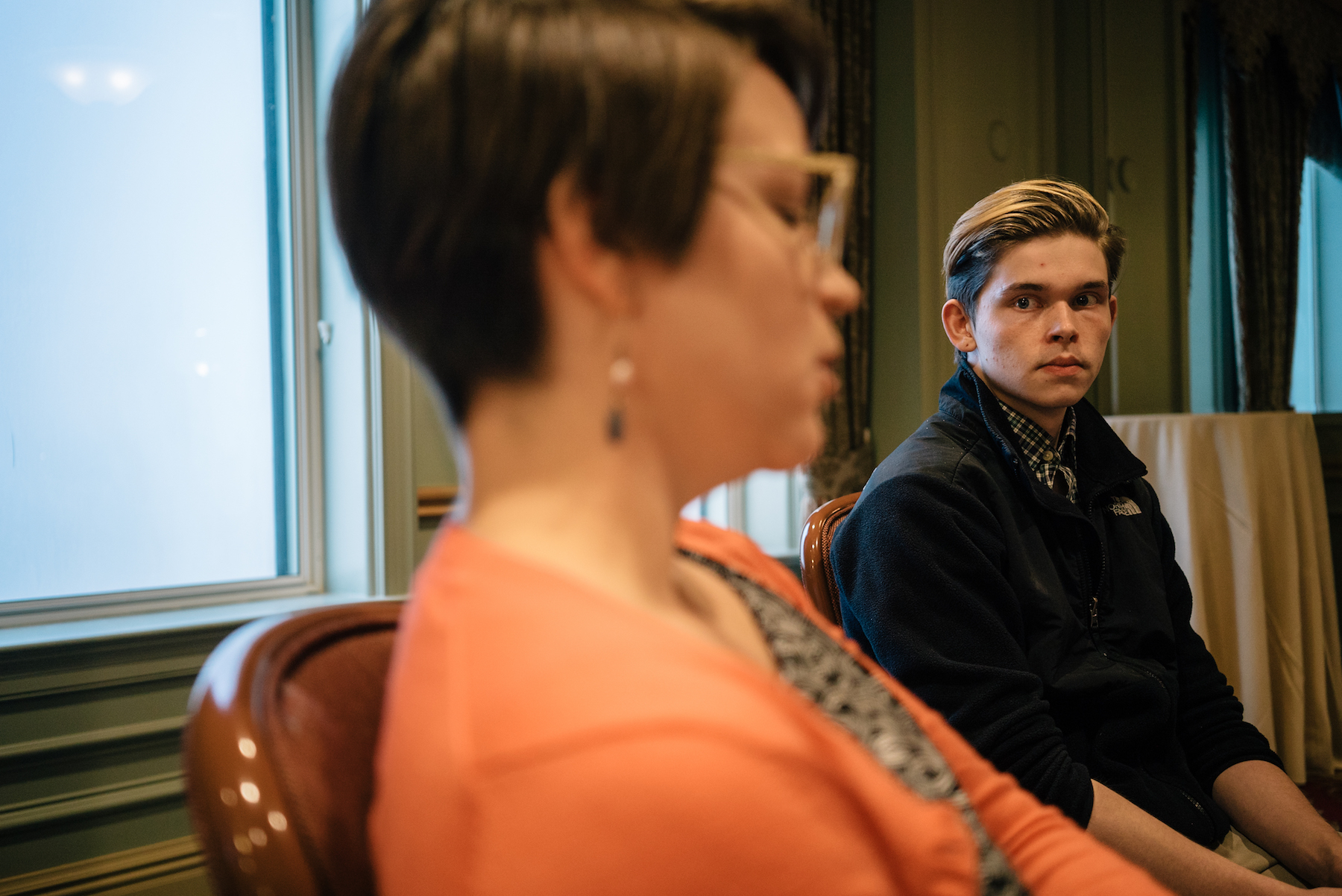
Texas Right to Life is far from the only anti-abortion group trying to ground its arguments in science. This year, the theme of the March for Life was “Unique from Day One,” based on the idea that a fertilized fetus has its own individual DNA. The six-week bans on abortion have spread thanks to Faith2Action, a nonprofit that bills itself as the “birthplace of the Heartbeat bill.” Its model legislation bans abortion after a “heartbeat” is detected, which it calls a “key medical predictor” that a fetus will be born alive. Versions of the “heartbeat” bill have been introduced in about two-dozen state legislatures, an Arizona Republic–USA Today investigation found.
While those six-week bans are not yet in effect, laws that would ban abortion after 20 weeks are, including in Texas. Groups like the powerful nonprofit Americans United for Life have pushed those kinds of restrictions; AUL’s model legislation instructs states to ban abortion “because of the pain felt by an unborn child upon being aborted.” (Texas Right to Life backed its state’s version of that ban.)
Americans United for Life literally writes the book on how to restrict abortion access, through its annual “pro-life playbook” of model state legislation. The Arizona Republic–USA Today report dubbed the group “the most prolific author of copycat abortion legislation” in the United States.
“If you’re engaging in dialogue with someone who does not believe in the same truth as you believe, that does not take the Bible as word, that maybe isn’t the same religion as you, and you’re Bible-thumping, you have no ground to stand on,” explained Ruiz, the Texas A&M senior who led one of the discussions about the Holocaust. Now in the second year of her fellowship, she also works as an intern in Texas Right to Life’s education department.
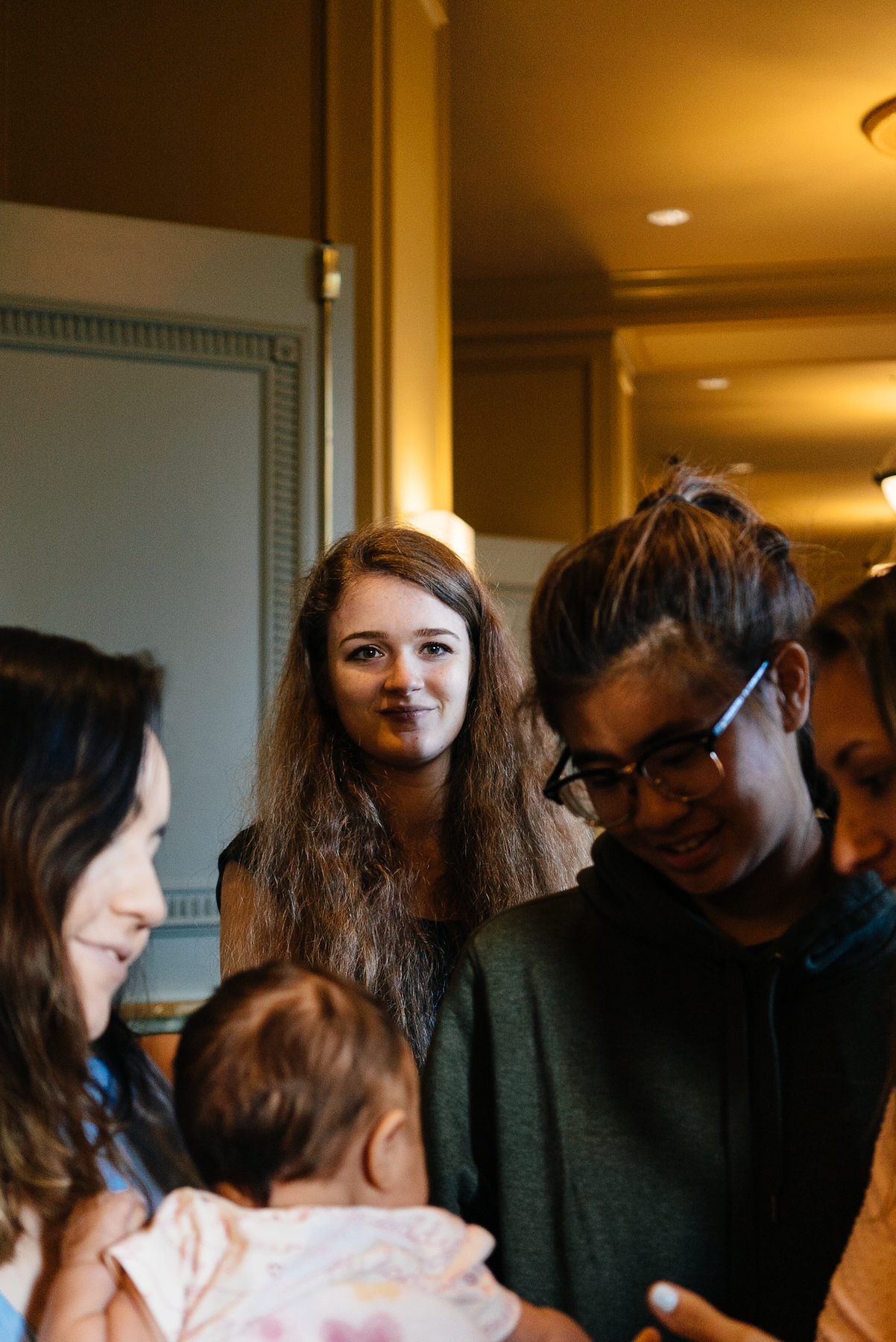
Last year, Ruiz stopped taking the injectable contraceptive Depo-Provera. Like most hormonal birth control, “the shot” primarily works by stopping ovulation, but it can also potentially block an egg from becoming fertilized or implanting in a woman’s uterus. Ruiz believes that a fertilized egg is already a person — and so the shot, in her mind, could cause an abortion.
Weeks after she stopped taking it, Ruiz attended her own first-year fellowship training. On the Friday night of that week, with just one day left in the program, Ruiz took a pregnancy test.
It was positive.
“I wanted to scream it at the rooftops!” Ruiz said, clapping her hands in excitement. “Like, oh my God, we’re at a pro-life camp, a pro-life fellowship, and there’s life inside me! I just wanted to tell everyone.”
Ruiz will graduate college in December. Her daughter is now five months old.
The creation of new life is much more of a gray area than this kind of rhetoric would suggest. Medically speaking, a pregnancy starts when a fertilized egg is implanted in the uterine lining, so blocking that egg from implantation is not an abortion.
At six weeks, a doctor can’t detect what’s typically described as a heartbeat — the thud of valves closing — because the fetus doesn’t have a fully formed heart. Instead, they can find the “electrically induced flickering of a portion of the fetal tissue that will become the heart,” Ted Anderson, president of the 58,000-member-strong American College of Obstetricians and Gynecologists (ACOG), told the Guardian earlier this year. While this flickering is usually a good sign that a pregnancy is healthy, it’s not necessarily more important than other milestones in a pregnancy.
Fetuses also cannot feel pain until the onset of viability, generally placed at around 24 weeks, according to ACOG (which has taken to titling its press releases about abortion “Facts Are Important”).
Texas Right to Life staffers say something is alive if it’s composed of cells; can pass along hereditary traits; has a metabolism; maintains homeostasis; and can grow, reproduce, and respond to its environment. But even the concept of life itself is, kind of absurdly, unresolved. While scientists do sometimes create similar lists of features that living organisms possess, there is no single, widely accepted definition of “life” or the qualities that prove something is “alive.”
At the same time, life is far more expansive than humans tend to think; biologists universally consider bacteria to be alive.
PRO-LIFE FEMINISM
Several of the sessions and lectures were closed to VICE News, including ones on topics like birth control, in vitro fertilization, and Planned Parenthood’s business model. But of the public sessions, none generated more wide-eyed fervor than Aimee Murphy’s.
Murphy arrived in Houston looking, well, cool. Her dark hair was streaked with vibrant blue and teal, and she just happened to mention that she has a tattoo (twice). Before her talk, called "Embracing the 'F Word': Learning to Love Pro-Life Feminism,” Murphy shrugged off a jacket bearing a patch demanding, “RESTORATIVE JUSTICE NOW.”
“I personally am a large clump of cells standing in solidarity with small clumps of cells, as long as they’re human,” Murphy told the students during her talk. She peppered it with phrases that wouldn’t sound too out of place on your average feminist Tumblr, but with an anti-abortion twist.

People believe that abortion will help them because of “the patriarchal structures which insist that the womb-less male body is the default,” Murphy said, and that treat pregnancy like a disease. Feminism that supports abortion rights also really “reinforces structures of inequality, discrimination, and violence,” while abortion deepens people’s “implicit bias,” ageism, and ableism against what Murphy calls the “preborn.”
According to Murphy’s logic, the fellows in the room all benefit from “born privilege,” in the same way white people enjoy white privilege.
“We’re learning that we can be powerful as a pregnant woman. We can be powerful as a mother.”
The students, fluent in the lingua franca of social justice, were enraptured. They may have grown up watching celebrities like Beyoncé and Taylor Swift declare themselves feminists, but their opposition to abortion has seemingly locked them out of joining that party. Murphy offered them not only an invitation but also historical proof that, apparently, they were the real feminists all along.
“The first wave of feminists in the U.S. were almost unanimously pro-life,” Murphy said, referring to the activists who primarily worked to secure women the right to vote in the 19th century and early 20th. “Because they understood that saying that women were less than men or were inherently disempowered through maternity was a form of the patriarchy’s insidious web into our culture.”
Second-wave feminists, in the 1960s through the ’80s, championed the sexual revolution; their luminaries signed a 1972 letter declaring, “We have had abortions.” By highlighting first-wavers’ opposition to abortion, the feminism of their descendents is framed as in need of a course correction.
It’s a seductive pitch, and Murphy isn’t the only member of the modern anti-abortion movement who’s making it. After all, one of the most powerful anti-abortion groups in the United States is the Susan B. Anthony List, named after the famous suffragette.
“We do want women in the workplace, because we want equal rights, because we’re feminists,” said Erin Quinn, a rising junior at the University of Dallas who said she was a feminist before Murphy’s talk. When she talks about being pro-life, her green eyes warm and her voice grows breathy. She’s alight with purpose.
“I love it. I feel like we’re thriving in this,” Quinn added. “Because we’re learning that we can be powerful as a pregnant woman. We can be powerful as a mother.”
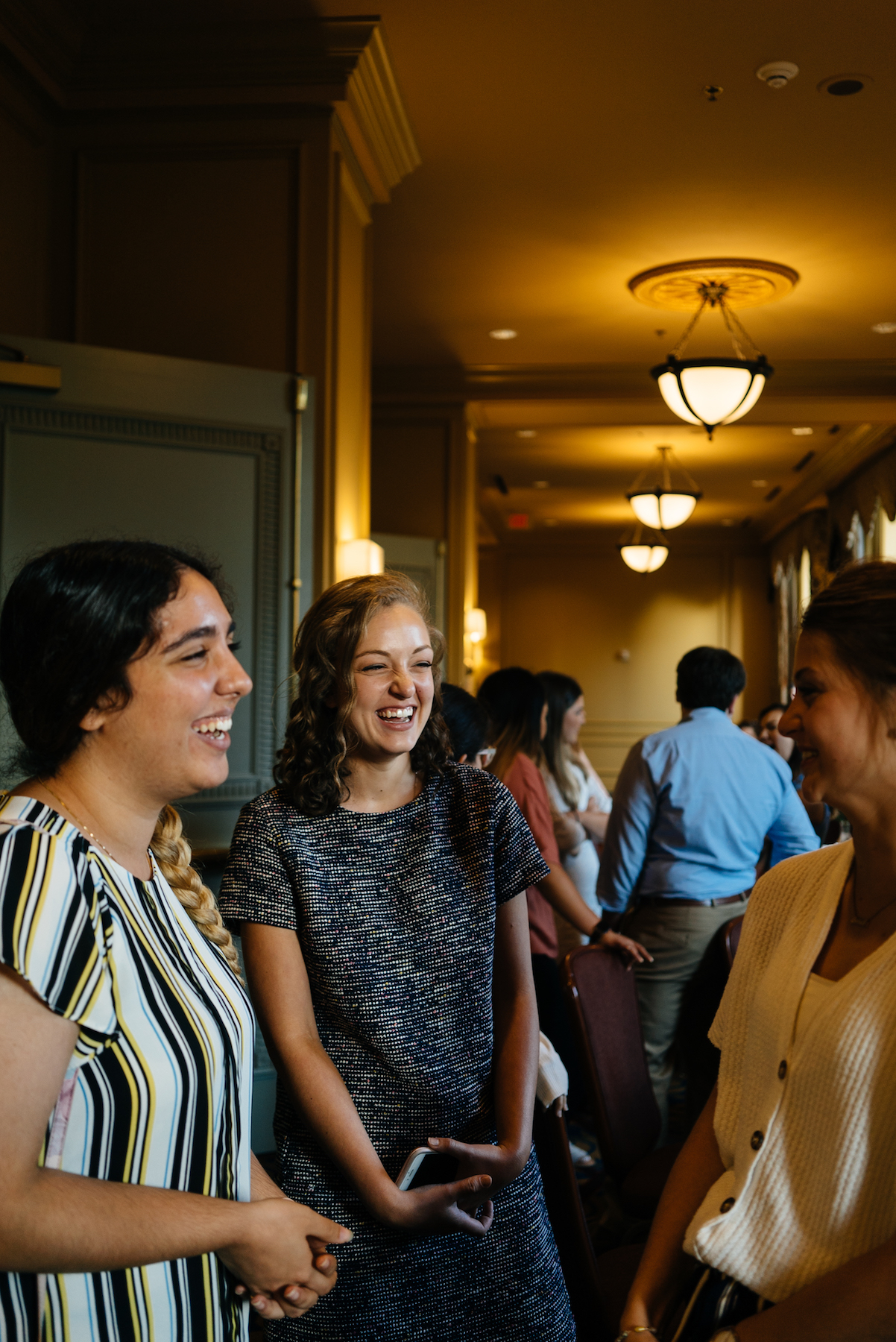
The abortion wars have long been portrayed as a standoff between the side that argues it is morally wrong to abort unborn children and the side that argues that reproductive choice is fundamental to women’s liberty. Anti-abortion advocates often fend off accusations that they’re merely “pro-birth” because they’re not focused on advancing policies that benefit infants and mothers, like parental leave or lessening maternal mortality.
“Typically, it’s Republicans who are like, ‘Abortion’s wrong,’ but typically it’s Democrats who are like, ‘No, we need to pour money into Medicaid, into food stamps, into WIC,” said Ruiz, referring to a federal assistance program for low-income mothers and children. Both parties, she said, should “get their heads on straight and come together.”
“Why can’t we save babies in the womb but also support mothers that maybe, at this point in life, don’t have resources? Like, she shouldn’t have to end the life of her child to provide food for herself and for her other children.”
At the training, the speakers and fellows tried to prove that they were women’s real champions, because they don’t want to penalize them for becoming mothers. They talked about giving scholarships to pregnant and parenting students, about running diaper drives. In a talk entitled “Post-Abortive Counseling,” students moaned in sympathy as a local therapist spoke about helping women recover from “post-abortion syndrome,” whose symptoms were compared to a kind of post-traumatic stress disorder. (In 2008, an American Psychological Association task force concluded that one first-trimester abortion is no riskier to a woman’s mental health than carrying a pregnancy to term.)
Though past generations of activists might have lurked outside clinics with posters of aborted fetuses and yelled “murderer!” at women who walked in, those kinds of tactics disgust many of the fellows today. When asked about them, Miller groaned. “That’s what also makes pro-life people look bad. Oh no, I hate that.”
“That is not gonna change their minds,” she explained. “That’s gonna make them more scared. It’s gonna make them worse. And then they’re gonna go to Planned Parenthood and they’re gonna be like, ‘Oh, we can help you, like, you know, blah blah, we can take care of it.’”
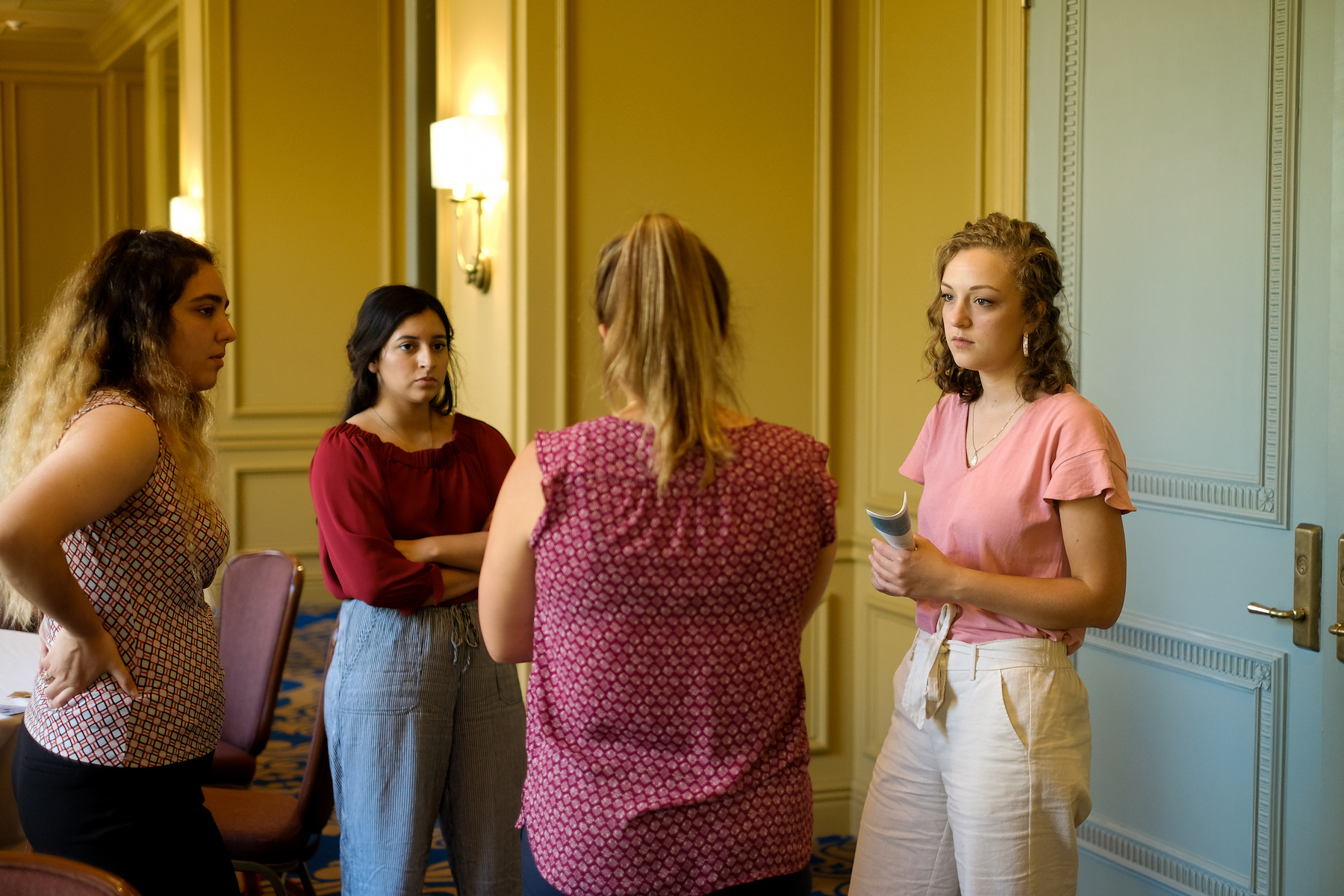
Toward the beginning of Murphy’s talk, she asked how many fellows considered themselves feminists. Only a handful raised their palms. But afterward, when Murphy asked how many people were now at least comfortable with the idea of feminism, nearly the entire room threw up their hands. Students mobbed Murphy, thanking her profusely for her speech and wondering aloud whether she could come speak at their schools.
Miller, for example, is all in.
“When [Murphy] said the nonviolence part, I was like, ‘OK, I’m here for this. I like this,’” she said. “It really is empowerment and equality, and I think that’s really, really important.”
IN THE STREETS, IN THE CAPITOL
The fellows might talk about changing the culture around abortion, but the Texas Right to Life has a clear legislative agenda. And it’s got the deep pockets and electoral firepower to turn it into reality.
A state affiliate of the powerful National Right to Life Committee, its political action committee spent about $3.5 million during the 2018 election cycle. It’s helped steer millions toward Texas’ controversial “Alternatives to Abortion” program, which uses state dollars to persuade women to not get abortions.
While Texas Right to Life hasn’t endorsed any “heartbeat” bills, it has successfully shepherded abortion restrictions like House Bill 2, which halved the number of abortion clinics in Texas, banned most abortions after 20 weeks of pregnancy, and ultimately triggered a historic Supreme Court battle. This state legislative session, Texas Right to Life deployed a record six full-time lobbyists to Austin.
It’s a comprehensive operation, and fellows are encouraged to throw themselves into it. A few weeks before the training in downtown Houston, second-year fellows in the Texas Right to Life program traveled to the Capitol to practice lobbying their representatives to fight abortion.
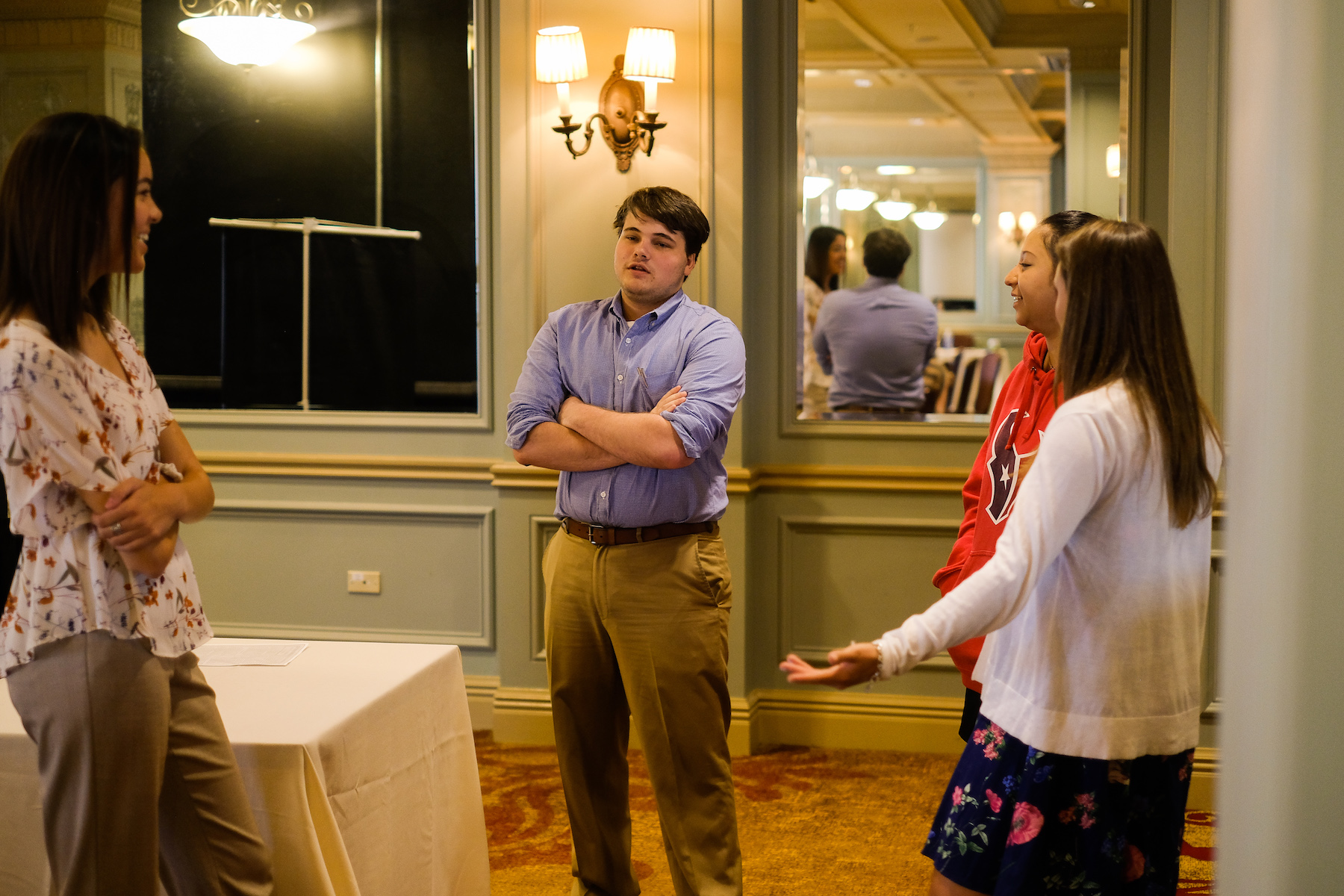
Ruiz was among those fellows. Despite her qualms about the Republican Party, ultimately, she said, “I personally vote first on abortion. So I will not vote for someone who is pro-abortion.”
The fellowship involves other perks, like an all-expenses-paid pilgrimage to the March for Life, a massive annual gathering of anti-abortion activists in Washington, D.C., that concludes with a protest on the steps of the Supreme Court. While the March doesn’t track the number of student groups who show up, it’s impossible to miss the scores of young people holding identical black-and-white signs that announce, “I am the pro-life generation.”
That’s the “signature sign” of Students for Life, which has nearly doubled its number of chapters over the last eight years. Today, it has more than 1,100 chapters, in all 50 states.
The March for Life also illustrates just how far the lessons taught in this Houston hotel have already travelled. Pull a student out of the herd to ask why they’re marching in Washington and they’ll tell you the same thing the Texas Right to Life fellows are repeating nearly 1,500 miles away: They want to make abortion not just illegal, but unthinkable.
But while Texas Right to Life and its fellows want to reinvent what being “pro-life” looks and sounds like, there are certain things that remain nonnegotiable. They might grimace at the protesters who yell at women outside Planned Parenthood, but they still go, too.
The day the fellows planned to stand outside a Planned Parenthood abortion clinic, Houston’s sweltering humidity and sunshine gave way to pouring rain. The fellows went anyway. Careful not to block the street or the clinic’s driveway, they stood on the sidewalk, huddling over rosaries and stretching their arms to the sky. As they sang hymns, one young woman’s crystalline voice soared above the patter of rain.
“We’re praying and just staying in solidarity with the women who are going in there, trying to show support, so they don’t feel like they have to go through an abortion,” said Kateri Remmes, a rising junior at the University of Dallas. She serves as president of her school club Crusaders for Life.
“It’s a life-or-death situation in this case, so I take it pretty seriously.”
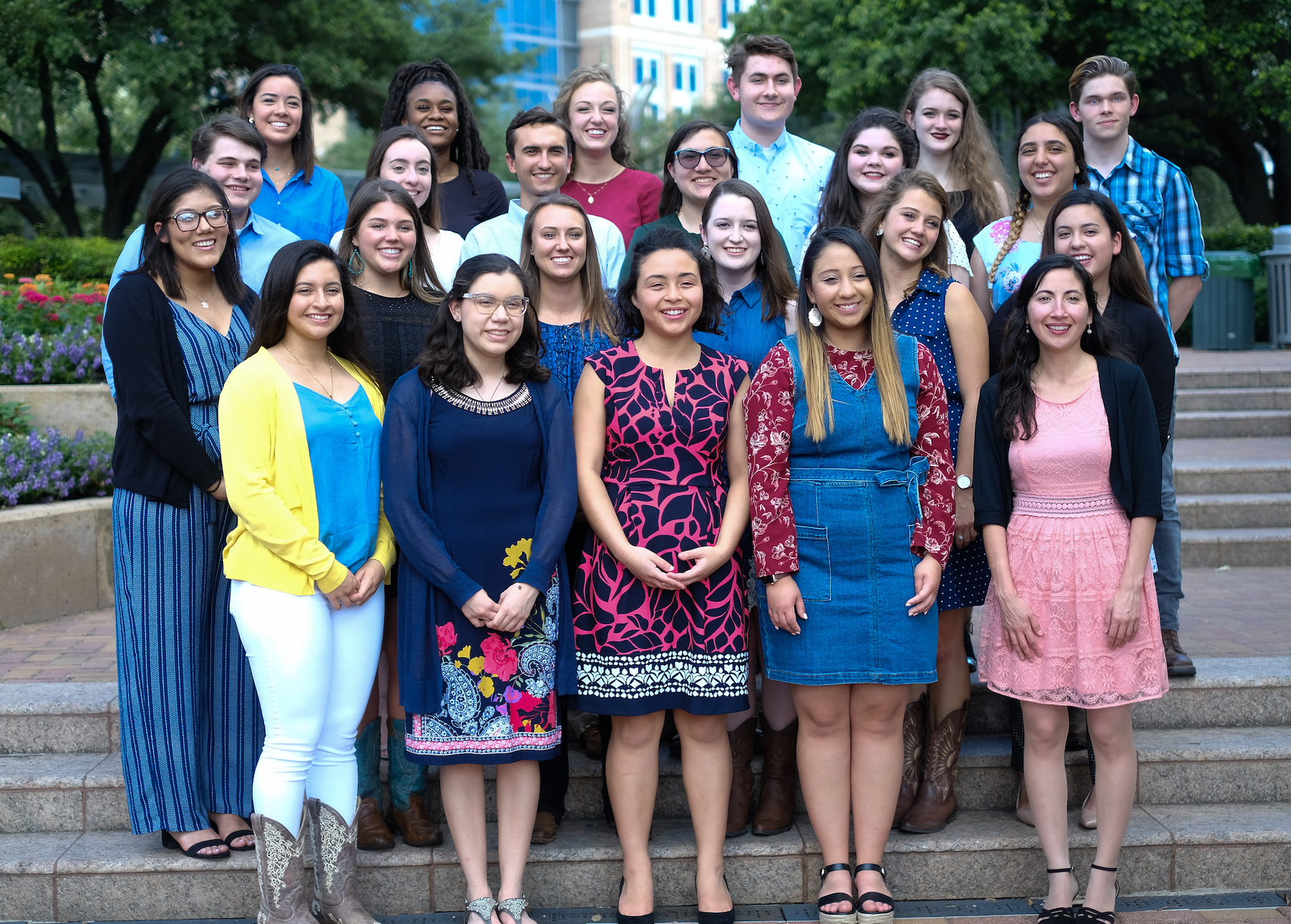
Cover: Students spent hours learning how to talk to strangers about abortion, right down to making sure they had welcoming body language. (Photo by Zach Caldwell.)
